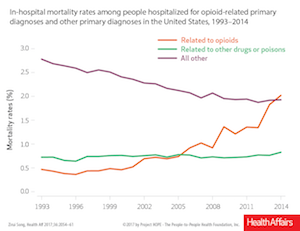Article
Who's Dying in Hospitals From Opioids? Major Study Says Disabled, Low-Income Whites on Medicare
Author(s):
Mortality rates from opioid-driven hospitalizations in the United States quadrupled over 2 decades, especially among older, white, low-income populations, according to a study published in Health Affairs. The analysis showed that people enrolled in Medicare, and not those in Medicaid, accounted for the fastest-growing share of opioid and heroin poisoning.
A new study mining a national database of hospital inpatients showed death rates from opioid-driven hospitalizations in the United States quadrupled over 2 decades, especially among older, white, low-income populations, according to results published in Health Affairs Monday.
The news comes as the federal government and states grapple with the rising toll of the opioid epidemic. The study’s author, Zirui Song, MD, PhD, an assistant professor of healthcare policy at Harvard Medical School and an internist at Massachusetts General Hospital, said the results point to an increased need to help hospital personnel respond to the increasing severity of patients with opioid toxicity.

This analysis showed that people enrolled in Medicare, and not those in Medicaid, accounted for the fastest-growing share of opioid and heroin poisoning (meaning those with a higher intensity of abuse). Medicare beneficiaries went from the smallest proportion of these hospitalizations in the 1990s to the largest share by the mid-2000s. The study is the first to use nationally representative, multipayer data between 1993 and 2014 from the National Inpatient Sample of the Healthcare Cost and Utilization Project to compare the composition of hospitalizations with opioid-related primary diagnoses and those of hospitalizations for other drugs and for all other causes.
“Currently, we have lots of awareness about the opioid epidemic—people treated at home and on the street are heavily attended to by emergency personnel,” said Song, who was the 2016 winner of the Seema S. Sonnad Emerging Leader in Managed Care Research Award from The American Journal of Managed Care®.
What isn’t known, however, was what was happening in the inpatient setting. To do that, he classified hospitalizations by their primary diagnosis code, in this case hospitalizations due to opioids in the International Classification of Diseases, Ninth Revision (ICD-9) diagnosis/procedure codes:
- Non-dependent opioid abuse
- Opioid dependence
- Opioid codependence with other substances
- Opioid poisoning
- Poisoning by a specific opioid product such as methadone or heroin
Non-opioid hospitalizations were split into 2 groups:
- Those with a primary diagnosis due to other drugs, such as alcohol, cocaine, and other substances
- All hospitalizations with other primary diagnoses
The database—which, historically, included information about all discharges from approximately 20% of hospitals nationwide—contains information for about 8 million annual hospitalizations obtained from a stratified sample of US hospitals. Beginning in 2012, it included information from about 20% of discharges from all participating hospitals.
After sample weights were applied to provide national estimates, hospitalizations broke down by:
- Hospitalizations due to opioids: 1,934,326
- Due to other drugs: 19,220,610
- From all other causes: 794,406,343
Regionally, a disproportionately large share of opioid-driven hospitalizations occurred in the Northeast (43.9%), despite the fact that the largest numbers of hospitalizations in this data came from the South and Midwest.
Before 2000, unadjusted in-hospital death rates for opioid-driven hospitalizations were relatively constant, averaging 0.43% (4.3 deaths per thousand admissions). Between 2000 and 2007, the rates more than doubled to 1.05%, and by 2014 they had nearly doubled again (to 2.02%, or 20.2 deaths per thousand admissions).
In contrast, mortality rates among hospitalizations due to other drugs remained stable, averaging 0.71% and 0.75% before and after 2000, respectively. The mortality trend for all other hospitalizations steadily fell throughout the period, from more than 5 times that for opioid-driven hospitalizations in 1993 to slightly below it by 2014.
On average, Medicare beneficiaries hospitalized for opioid or heroin poisoning were younger—59.8 years old—than those hospitalized for other reasons. Medicare beneficiaries hospitalized for other drugs were 63.6 years old; those hospitalized for all other reasons were 73.6 years old.
Overall, 59.3% of Medicare beneficiaries hospitalized for opioid or heroin poisoning were younger than age 65. Since most Medicare beneficiaries younger than 65 receive Social Security Disability Insurance, it is likely that those hospitalized for opioid or heroin poisoning were likely to have physical or mental disabilities.
“Until community-based efforts to tackle opioid misuse have taken root, treating opioid addiction and better equipping hospitals to care for patients with increasingly severe opioid abuse may help the health care system combat the rising mortality rates of patients hospitalized for opioid use disorders,” the study concluded.
In an interview, Song praised overall awareness of the opioid crisis and life-saving interventions like naloxone, which reverses an overdose if given in time. “First responders and Narcan [naloxone] have been doing a tremendous job of saving lives in the community,” he said.
With this study—the first of its kind—he wanted a clean data set that only looked at hospital admissions with opioids in the primary diagnosis code. “In the hospital setting, providers are often stretched thin, pulled by many patients at once,” he said.
Song noted in his study that although the federal government has begun to take steps to address this issue through increased funding, implementing solutions among the most vulnerable populations remains a challenge. Nevertheless, regardless of where the funding comes from, he said the severity and scope of the problem demands to be addressed, as costs are borne by either patients and families, payers such as Medicare, hospitals, and ultimately by society through lost contributions.
“Collectively, it is a challenge for society as a whole,” he said
The study had a few limitations:
- For confidentiality reasons, patient identifiers were removed, so each observation was distinct (readmissions were not identifiable).
- The sampling strategy in the National Inpatient Sample changed in 2012. However, the data continued to capture about 20% of hospitalizations nationwide.
- ICD-9 diagnosis codes are likely to have some degree of subjectivity and measurement error. Nevertheless, the codes are the best tool available in most databases for identifying the cause of hospitalization.
Reference
Song Z. Mortality quadrupled among opioid-driven hospitalizations, notably within lower-income and disabled white populations. Health Aff. 2017;36(12):2054-2061. doi: 10.1377/hlthaff.2017.0689.
Newsletter
Stay ahead of policy, cost, and value—subscribe to AJMC for expert insights at the intersection of clinical care and health economics.





